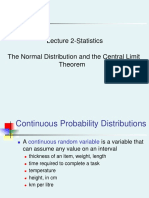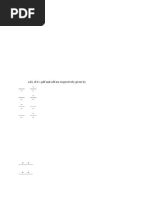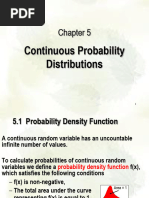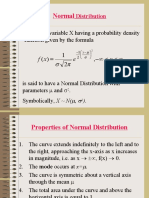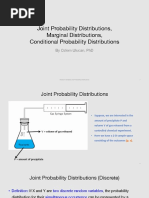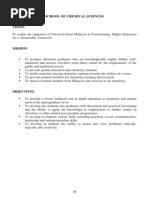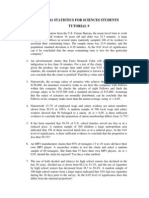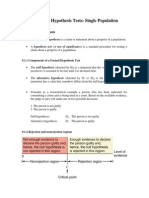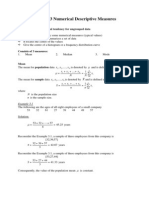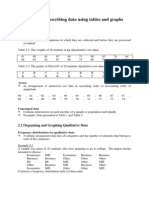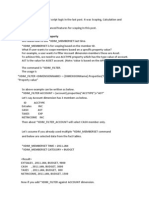Chapter 6
Chapter 6
Uploaded by
Khay OngCopyright:
Available Formats
Chapter 6
Chapter 6
Uploaded by
Khay OngOriginal Description:
Copyright
Available Formats
Share this document
Did you find this document useful?
Is this content inappropriate?
Copyright:
Available Formats
Chapter 6
Chapter 6
Uploaded by
Khay OngCopyright:
Available Formats
Chapter 6 Continuous Random Variable
6.1 Continuous Probability Distribution
A continuous random variable is a random variable whose values are not countable, it can
assume any value over an interval or intervals.
For example, the life of a battery, heights of persons, time taken to complete a test, etc, are
continuous random variables.
The probability that a continuous random variable X assumes a single valueis always zero.
That is, 0 ) ( = = a X P
Therefore, for a continuous random variable X, we will also call its probability distribution
curve, probability density function. This function, ) (x f , satisfies the following properties:
i) 0 ) ( > x f , for all x.
ii) The total area between the curve of ) (x f and the x-axis is always 1, that is
1 ) ( =
}
dx x f
iii) dx x f b X a P
b
a
}
= < < ) ( ) ( .
Note that : ) ( ) ( ) ( ) ( b X a P b X a P b X a P b X a P s s = s < = < s = < <
Mean
Let X be a continuous random variable with probability density function ) (x f . The mean or
expected value of X is
}
= = dx x f x X E ) ( ) ( .
Variance
Let X be a continuous random variable with probability density function ) (x f and mean .
The variance of X is
}
= = = dx x f x X E X Var
X
) ( ) ( ] ) [( ) (
2 2 2
o
or
2 2 2 2 2
) ( ) ( ) ( o = = =
}
dx x f x X E X Var
X
Example 6.1: The continuous random variable of X has the probability density function as
follows:
/ 8 0 4
( )
0
x x
f x
otherwise
< <
=
Find E(X) and Var(X).
Solution:
6.2 The Uniform Distribution
A continuous random variable, X has a uniform distribution if its values spread evenly over
the range of [a,b] and denoted as X~Uniform(a,b). Thus the probability density function f (x)
is
,
1
) (
a b
x f
= a s x s b
f(x)
f(x) = 1/(b a)
1/(b a)
x = a x = b x
The graph of a uniform distribution results in a rectangular shape.
The Uniform probability for a certain range
Unifrom Probability random variable, X between two potins x
1
and x
2
can be obtained by
integrating the density function from x
1
to x
2
, as follows:
}
= s s
2
1
) ( ) (
2 1
x
x
dx x f x X x P
}
=
2
1
1
x
x
dx
a b
) (
1
1 2
x x
a b
=
The output of the integration above is as same as area for a rectangle with the width of (x
2
x
1
) and the height of 1/(b - a). Therefore, without requiring any integrating action, the uniform
probability X by these points x
1
and x
2
in the range of [a, b] is:
f(x) = 1/(b a)
1/(b a)
a x
1
x
2
b x
Mean X dan variance X are given as follows:
E(X) =
x
= (a + b)/2
Var(X) = o
x
2
= (b a)
2
/12
Example 6.2: Let the random variable X is distributed as continuous uniform in the range of 2 to 6.
Find
(i) Probability density X (ii) P(3 s X s 4)
(iii) P(X > 3.5) (iv) E(X) and Var(X)
Solutions:
Example 6.3: The time when a used car is experiencing a first broken damage after being sold, is
known distributed as continuously uniform in range of 0 to 6 months. Assumed a dealer guarantees
that the car is not experiencing any broken damage within 60 days period after being sold,
(i) What is the probability that the used car that has been sold will be firstly broken in the period of
the warranty?
(ii) When will be the sold car expected to suffer the first broken?
Solution:
6.3 The Normal Distribution
The normal distribution is one of the many probability distributions that a continuous random
variable can possess. The normal distribution is the most important and most widely used of
all probability distributions.
The normal probability distribution or the normal curve is a bell-shaped (symmetric) curve,
its mean is denoted by and its standard deviation by .
The properties of a normally distributed variable:
1. The total area beyond this curve, f(x) is 1.0.
Area = 1.0 f(x)
x
2. The curve f(x) is symmetric around its mean, . Therefore:
Area of left side of = Area of right side of = 0.5
0.5 0.5 x
3. Since f(x) is symmetric towards its mean, all values of mean, median and mode are all
same.
x
min = median = mod
4. The tail at the left and right sides of the curve f(x) extend to the infinity. The curve does not
touch the x -axis; but it approximates the x -axis until the area between the points x =
3o and x = + 3o is approaching 1.0.
Area ~ 1.0
x x +
3o + 3o
The probability density function of a normal distribution is
( )
0 , ,
2
exp
2
1
) (
2
2
> < < < <
(
= o
o
t o
x
x
x f
2
2
2
) (
2
1
) (
o
t o
=
x
e x f
x
If X~ ) , (
2
o N , then the mean and the variance of X are
= = ) (X E
X
and
2 2
) ( o o = = X V
X
, respectively.
Three normal distributions with the same value of mean, i.e.
1
=
2
=
3
= 20 and the
respectively standard deviations o
1
= 5, o
2
= 10,
o
3
= 16.
Three normal distributions that contain the respective means
1
= 10,
2
= 20,
3
= 30 and the
same standard deviation, o
1
= o
2
= o
3
= 16.
6.3.1 The Standard Normal Distribution
A normally distributed variable having mean 0 and standard deviation 1 is said to have the
standard normal distribution.
Standard Normal Probability Density Function:
,
2
1
) (
2
2
z
e z f
=
t
< < z
f(z)
-3 -2 -1 = 0 1 2 3 z
To calculate the standard Normal probability between two points
and
.
}
= s s
2
1
) ( ) (
2 1
z
z
dz z f z Z z P
dz e
z
z
z
}
=
2
1
2
2
2
1
t
The above integral cannot be solved explicitly. However the probability can be easily
determined using Standard Normal Table which reports the probability that a standard normal
random variable has probability less than or equal to constant z.
Assumed
and
are two values of standard normal distribution, with
<
. The
following are true towards the probability of Z:
P(
s Z s
) area of region between
= P(Z s
P(Z s
and
z
P(Z s
) = 1 P(Z >
) area of region from left of
z
P(Z >
) = 1 P(Z s
) area of region from right of
z
The location points of
and
in the z-axis depend at their sign; if the sign is positive, the
location point is at the right of the zero point and if the sign is negative, the location of the
point is at the left from zero point.
Finding Probabilities When Given z Values
Table 4. The Normal Distribution Function (Cambridge Statistical Tables) lists the
probability of standard normal distribution at the range of ( , z), i.e. the probability Z in
form of:
) ( ) ( z Z P z s = u
This probability is equal to the area of region beyond the normal curve, from - to z, i.e. the
area of the region in the left hand side of z.
u(z) N(0,1)
0 z
The following is the example of the values of z and its probability, ) ( ) ( z Z P z s = u , which can
be obtained from the standard normal Table, Table 4: The Normal Distribution Function :
z u(z) z u(z)
0.00 0.5000 0.40 0.6554
.10 .5398 .50 .6915 ) 10 . 1 ( ) 10 . 1 ( s = Z P u
.20 .5793 1.10 .8643 = 0.8643
.30 .6179 1.72 .9573
Example 6.4: Find the following probability Z and sketch the probability area
(i) P(Z s 0.00) (ii) P(Z s 1.12) (iii) P(Z > 1.72) (iv) P(0.30 s Z s 1.72)
Solutions:
If z is a negative value, the probability of Z is determine using the symmetry property of the
standard Normal distribution about their mean, 0 by assuming z is a positive value where z > 0.
P(Z s z) = P(Z > z)
= 1 P(Z s z)
- z 0 z
and P(Z > z) = P(Z s z)
- z 0 z - z 0 z
Example 6.5: Find the probabilities of the following Z. Shade the areas for each of the
probabilities.
(i) P(Z s 1.10) (ii) (Z > 1.10) (iii) P( Z s 1.10) (iv) P( Z > 1.10)
Solution:
6.4 Standardizing a Normal distribution
The standardized version of a normally distributed variable X ,
o
=
x
Z , has the standard
normal distribution. This is also called the z values or z scores.
Example 6.6: Let x be a random variable that has a normal distribution with a mean of 40 and
a standard deviation of 5. Find the following probabilities for this normal distribution.
a) P(X > 55) b) P(X < 49) c) P(42 < X < 50) d) P(32 < X < 38)
Solution:
Example 6.7: Hupper Corporation produces many types of soft drinks, including Orange
Cola. The filling machines are adjusted to pour 12 ounces of soda can of Orange Cola.
However, the actual amount of soda poured into each can is not exactly 12 ounces; it varies
from can to can. It has been observed that the net amount of soda in such a can has a normal
distribution with a mean of 12 ounces and a standard deviation of 0.015 ounce.
a) What is the probability that a randomly selected can of Orange Cola contains 11.97 to
11.99 ounces of soda?
b) What percentage of the Orange Cola cans contain 12.02 to 12.07 ounces of soda?
Solution:
Example 6.8: The life span of a calculator has a normal distribution with a mean of 54
months and a standard deviation of 8 months. The company guarantees that any calculator
that starts malfunctioning within 36 months of the purchase will be replaced by a new one.
About what percentage of calculators made by this company are expected to be replaced?
Solution:
6.5 Determining the z and x values when an area under the Normal
distribution curve is known
Sometimes we have to determine the interval under the normal curve given a fixed probability. This
situation is opposite of what we encounter previously.
To determine the values of z using a fixed probability, we still use Table 4 but now we read the table
from right (column (z)) to left, (column z).
z u(z) z u(z)
0.00 0.5000 0.40 0.6554
.10 .5398 .50 .6915 ) 10 . 1 ( ) 10 . 1 ( 8643 . 0 s = u = Z P
.20 .5793 1.10 .8643
.30 .6179 1.72 .9573
Example 6.9.: Find the values of z so that
(i) P(Z s z) = 0.9573 (ii) P(Z > z) = 0.3085
(iii) P(-z s Z s z) = 0.50 (iv) P(Z s z) = 0.10
Solution:
Example 6.10: The life span of a calculator has a normal distribution with a mean of 54
months and a standard deviation of 8 months. What should the warranty period be to replace a
malfunctioning calculator if the company does not want to replace more than 1% of all the
calculators sold?
Solution:
6.6 The Normal Approximation to the Binomial Distribution
- The normal distribution can be used as an approximation to the binomial distribution when
np and nq are both greater than 5, that is if 5 5 > > nq and np . That is,
if X ~ B(n, p), then X ~ N(np, npq)
- An addition of 0.5 and/or subtraction of 0.5 from the value(s) of x when the normal
distribution is used as an approximation to the binomial distribution is called the continuity
correction factor.
Example 6.11: According to an estimate, 50% of the people in America have at least one
credit card. If a random sample of 30 persons is selected, what is the probability that 19 of
them will have at least one credit card?
Solution:
Method 1: exact answer
) 5 . 0 , 30 ( ~ = = p n B X ,
using the Binomial distribution, P(X = 19) 0509 . 0 ) 5 . 0 ( ) 5 . 0 (
11 19
19
30
= = C
Method 2: approximation
Mean 15 ) 5 . 0 ( 30 = = = np
Variance 5 . 7 ) 5 . 0 )( 5 . 0 ( 30
2
= = = npq o
) 5 . 19 5 . 18 ( ) 19 ( < < = = X P X P
|
|
.
|
\
|
< <
=
5 . 7
15 5 . 19
5 . 7
15 5 . 18
Z P
) 643 . 1 278 . 1 ( < < = Z P
0498 . 0 =
Example 6.12: According to a joint reader survey by USATODAY.com and
TripAdvisor.com, 34% of the people surveyed said that the first thing they do after checking
into a hotel is to adjust the thermostat (USA TODAY, June 12, 2009). Suppose that this result
is true for the current population of all adult Americans who stay in hotels. What is the
probability that in a random sample of 400 adult American who stay in hotels, 115 to 130 will
say that the first thing they do after checking into a hotel is to adjust the thermostat?
Solution:
Example 6.13: According to an American Laser Centers survey, 32% of adult men said that
their stomach is the least favorite part of their body (USA TODAY, March 10, 2009). Assume
that this percentage is true for the current population of adult men. What is the probability that
170 or more adult men in a random sample of 500 will say that their stomach is the least
favorite part of their body?
Solution:
You might also like
- This Study Resource Was: Assignment Brief - Semester 1Document6 pagesThis Study Resource Was: Assignment Brief - Semester 1HugsNo ratings yet
- Prelim Exam - Introduction To Human Computer InteractionDocument10 pagesPrelim Exam - Introduction To Human Computer Interactiongellert grindelwaldNo ratings yet
- Chpater 6 - Continous Random Variables and The Normal DistributionDocument11 pagesChpater 6 - Continous Random Variables and The Normal Distributionbishoy sefinNo ratings yet
- WordPress WP Elevation Proposal TemplateDocument11 pagesWordPress WP Elevation Proposal TemplateMahmoud HasanNo ratings yet
- Game Design Document Final PDFDocument7 pagesGame Design Document Final PDFTrọng HậuNo ratings yet
- Chapter 2: Continuous Probability DistributionsDocument4 pagesChapter 2: Continuous Probability DistributionsRUHDRANo ratings yet
- Normal Probaility DistributionDocument13 pagesNormal Probaility DistributionAbdul TukurNo ratings yet
- 3 Continuous Probability Distributions - 240210 - 070545-1Document7 pages3 Continuous Probability Distributions - 240210 - 070545-1AkaNo ratings yet
- Handout 03 Continuous Random VariablesDocument18 pagesHandout 03 Continuous Random Variablesmuhammad ali100% (1)
- Lecture9 SlidesDocument10 pagesLecture9 SlidesphilopateerNo ratings yet
- The Uniform DistributnDocument7 pagesThe Uniform DistributnsajeerNo ratings yet
- Term 1: Business Statistics: Session 4: Continuous Probability DistributionsDocument26 pagesTerm 1: Business Statistics: Session 4: Continuous Probability DistributionsTanuj LalchandaniNo ratings yet
- SLIDES Probability-Part3Document17 pagesSLIDES Probability-Part3nganda234082eNo ratings yet
- 11 - Queing Theory Part 1Document31 pages11 - Queing Theory Part 1sairamNo ratings yet
- FBA1202 Statistics W10Document104 pagesFBA1202 Statistics W10ilayda demirNo ratings yet
- Statistics HandoutDocument15 pagesStatistics HandoutAnish GargNo ratings yet
- Lecture 09Document15 pagesLecture 09nandish mehtaNo ratings yet
- ND Class 8 FebDocument41 pagesND Class 8 FebASIF ALI KHANNo ratings yet
- EDA01 Normal DistributionDocument14 pagesEDA01 Normal DistributionRica SantosNo ratings yet
- Continuous Prob DistDocument79 pagesContinuous Prob DistAkshay goelNo ratings yet
- Normal DistributionDocument26 pagesNormal DistributionUmesh ChandraNo ratings yet
- Ch.3 - Ch.4 - Ch.5 RV-PD - Part IDocument82 pagesCh.3 - Ch.4 - Ch.5 RV-PD - Part ImariasharaiyraNo ratings yet
- Chapter 3: Random Variables: Random Variable Assigns A Numerical Value To EachDocument19 pagesChapter 3: Random Variables: Random Variable Assigns A Numerical Value To EachCindyNo ratings yet
- Probability DistributionDocument37 pagesProbability Distributionalborz99100% (7)
- Random Variables and Probability Distributions: Topic 5Document15 pagesRandom Variables and Probability Distributions: Topic 5Uswatun Hasanah zaini100% (1)
- Lecture11 (Week 12) UpdatedDocument34 pagesLecture11 (Week 12) UpdatedBrian LiNo ratings yet
- Discrete Random Variables (DRV) SummaryDocument4 pagesDiscrete Random Variables (DRV) SummaryBeatrix KohNo ratings yet
- Lecture 2-Statistics The Normal Distribution and The Central Limit TheoremDocument73 pagesLecture 2-Statistics The Normal Distribution and The Central Limit TheoremDstormNo ratings yet
- LectureDocument6 pagesLectureJubillee MagsinoNo ratings yet
- STAT202 NO ANSWERS_122655Document46 pagesSTAT202 NO ANSWERS_122655unofficial.muhdNo ratings yet
- Random Variables and Probability Distribution: Purnomo Jurusan Teknik Mesin UGMDocument48 pagesRandom Variables and Probability Distribution: Purnomo Jurusan Teknik Mesin UGMYusnanda Agus NNo ratings yet
- Normal DistributionDocument59 pagesNormal DistributionAkash Katariya100% (1)
- Probability DistributionDocument21 pagesProbability Distributiontaysirbest0% (1)
- Most Important Theoratical Questions of QTDocument26 pagesMost Important Theoratical Questions of QTIsmith PokhrelNo ratings yet
- Queing Theory 2023-24Document40 pagesQueing Theory 2023-24Sakiya PNo ratings yet
- Chapter 3 StatisticDocument8 pagesChapter 3 Statisticsisayshimelis70No ratings yet
- Probability Formula SheetDocument11 pagesProbability Formula SheetJake RoosenbloomNo ratings yet
- Probability DistributionDocument17 pagesProbability DistributionMasudur RahmanNo ratings yet
- Topic20 8p7 GalvinDocument53 pagesTopic20 8p7 GalvinJude SantosNo ratings yet
- 5 BMGT 220 Normal DistributionDocument10 pages5 BMGT 220 Normal DistributionPamela Chimwani100% (1)
- Slide Chap4Document22 pagesSlide Chap4pmthai201No ratings yet
- CH 05Document76 pagesCH 05Michael FernoNo ratings yet
- Part 2 - Probability Distribution FunctionsDocument31 pagesPart 2 - Probability Distribution FunctionsSabrinaFuschettoNo ratings yet
- Continuous Probability DistributionDocument47 pagesContinuous Probability DistributionBrigitta AngelinaNo ratings yet
- Chapter 5 - Continuous Probability DistributionDocument42 pagesChapter 5 - Continuous Probability DistributionDiep Anh PhanNo ratings yet
- Multivariate DistributionsDocument8 pagesMultivariate DistributionsArima AckermanNo ratings yet
- Stats Cheat SheetsDocument15 pagesStats Cheat SheetsClaudia YangNo ratings yet
- Normal: A Random Variable X Having A Probability Density Function Given by The FormulaDocument38 pagesNormal: A Random Variable X Having A Probability Density Function Given by The FormulaShruti KapoorNo ratings yet
- Multi Varia Da 1Document59 pagesMulti Varia Da 1pereiraomarNo ratings yet
- Random VariablesDocument4 pagesRandom VariablesAbdulrahman SerhalNo ratings yet
- Continuous Probability DistributionsDocument51 pagesContinuous Probability DistributionsDUNG HO PHAM PHUONGNo ratings yet
- Chapter 3 NorDIsDocument73 pagesChapter 3 NorDIsreg.anything29No ratings yet
- Normal Proby DistributionDocument12 pagesNormal Proby DistributionFrancis Remorin ViloriaNo ratings yet
- Distribuciones de ProbabilidadesDocument10 pagesDistribuciones de ProbabilidadesPatricio Antonio VegaNo ratings yet
- Chapter 4: Probability Distributions: 4.1 Random VariablesDocument53 pagesChapter 4: Probability Distributions: 4.1 Random VariablesGanesh Nagal100% (1)
- Continuous Ran VarDocument12 pagesContinuous Ran VarJoshNo ratings yet
- Chapter 4Document36 pagesChapter 4Sumedh KakdeNo ratings yet
- SSP4SE AppaDocument10 pagesSSP4SE AppaÖzkan KaleNo ratings yet
- conditional normal distributionDocument10 pagesconditional normal distributionrcouchNo ratings yet
- 2019-20 ExamDocument7 pages2019-20 Examredhen430No ratings yet
- Week 5_Lesson2b_NormalDocument31 pagesWeek 5_Lesson2b_Normalraicy22205101104No ratings yet
- Week - 4 - Joint Probability Distributions, Marginal Distributions, Conditional Probability DistributionsDocument21 pagesWeek - 4 - Joint Probability Distributions, Marginal Distributions, Conditional Probability DistributionsDilara Küçükkurt100% (1)
- 8366probability Summary SheetDocument4 pages8366probability Summary Sheeteermac949No ratings yet
- A-level Maths Revision: Cheeky Revision ShortcutsFrom EverandA-level Maths Revision: Cheeky Revision ShortcutsRating: 3.5 out of 5 stars3.5/5 (8)
- Gunaan CONTENT 2011-2012Document42 pagesGunaan CONTENT 2011-2012Khay OngNo ratings yet
- Tutorial 9Document1 pageTutorial 9Khay OngNo ratings yet
- Tutorial 7Document1 pageTutorial 7Khay OngNo ratings yet
- Maa 161 Statistics For Sciences Students Tutorial 11: No. of Heads FrequencyDocument1 pageMaa 161 Statistics For Sciences Students Tutorial 11: No. of Heads FrequencyKhay OngNo ratings yet
- Tutorial 8Document1 pageTutorial 8Khay OngNo ratings yet
- Tutorial 5Document2 pagesTutorial 5Khay OngNo ratings yet
- Tutorial 6Document1 pageTutorial 6Khay OngNo ratings yet
- Tutorial 4Document2 pagesTutorial 4Khay OngNo ratings yet
- Tutorial 3Document2 pagesTutorial 3Khay OngNo ratings yet
- Tutorial 1Document2 pagesTutorial 1Khay OngNo ratings yet
- Chapter 11Document6 pagesChapter 11Khay OngNo ratings yet
- Chapter 10Document13 pagesChapter 10Khay OngNo ratings yet
- Solutions of Tutorial 5Document2 pagesSolutions of Tutorial 5Khay OngNo ratings yet
- Chapter 9Document14 pagesChapter 9Khay OngNo ratings yet
- Chapter 7Document15 pagesChapter 7Khay OngNo ratings yet
- Chapter 3 Numerical Descriptive Measures: 3.1 Measures of Central Tendency For Ungrouped DataDocument14 pagesChapter 3 Numerical Descriptive Measures: 3.1 Measures of Central Tendency For Ungrouped DataKhay OngNo ratings yet
- Chapter 4Document14 pagesChapter 4Khay OngNo ratings yet
- Chapter 2 Describing Data Using Tables and GraphsDocument16 pagesChapter 2 Describing Data Using Tables and GraphsKhay OngNo ratings yet
- Amity, Analog Electronics-2 (B.tech 4th Sem-Ece)Document1 pageAmity, Analog Electronics-2 (B.tech 4th Sem-Ece)deepak173No ratings yet
- SIPROTEC 7SJ66 - Profile PDFDocument2 pagesSIPROTEC 7SJ66 - Profile PDFsarodepiyushNo ratings yet
- Multiple FactoryTalk View SE Applications Within A Single FactoryTalk DirectoryDocument4 pagesMultiple FactoryTalk View SE Applications Within A Single FactoryTalk Directoryksahil2410No ratings yet
- Scope Using Member PropertyDocument5 pagesScope Using Member PropertyShahid AlimamodNo ratings yet
- Fundamentals of Wireless Communication - (CHAPTER 1 Introduction) PDFDocument9 pagesFundamentals of Wireless Communication - (CHAPTER 1 Introduction) PDFJatinder KumarNo ratings yet
- Pen Testing AssignmentDocument4 pagesPen Testing AssignmentAta AliNo ratings yet
- Anuna Confidence Nneoma-Design and Implementation of A Quiz Application For Android DeviceDocument76 pagesAnuna Confidence Nneoma-Design and Implementation of A Quiz Application For Android DeviceOlalekan AbdulRasheed OgunjimiNo ratings yet
- Account and Contact ManagementDocument34 pagesAccount and Contact ManagementHari Swamy50% (2)
- Advanced Power Electronics Corp.: AP4525GEMDocument7 pagesAdvanced Power Electronics Corp.: AP4525GEMsontuyet82No ratings yet
- Robotics and Automation s7 & s8Document282 pagesRobotics and Automation s7 & s8qyqfkrbbkzNo ratings yet
- Marantz Hd-Amp1 Amplifier User ManualDocument77 pagesMarantz Hd-Amp1 Amplifier User ManualreyfaldyeNo ratings yet
- GPS, GSM Based Vehicle Tracking and Security SystemDocument23 pagesGPS, GSM Based Vehicle Tracking and Security SystemTsegaye urgessaNo ratings yet
- Lecture 7 - Data Acquisition Basics and Intro To NI-ELVISDocument29 pagesLecture 7 - Data Acquisition Basics and Intro To NI-ELVISRohit Kumar SinghNo ratings yet
- TR-Electronic Products Assembly and Servicing NC IIDocument74 pagesTR-Electronic Products Assembly and Servicing NC IIPulxar TVINo ratings yet
- Manage Product Keys Using VAMT 2.0Document5 pagesManage Product Keys Using VAMT 2.0Maestro Pisika LptNo ratings yet
- Continuous OptimizationDocument51 pagesContinuous Optimizationlaphv494No ratings yet
- Pinnacle Plus Series: Online Double Conversion UPS Tower/19" Rackmount Version: 700 To 6000VADocument2 pagesPinnacle Plus Series: Online Double Conversion UPS Tower/19" Rackmount Version: 700 To 6000VAJulio AltamiranoNo ratings yet
- FT991 Installation 1Document2 pagesFT991 Installation 1OviNo ratings yet
- Chapter - 1Document22 pagesChapter - 1فخامة مبرمجNo ratings yet
- Capítulo 3 - Análisis Univariante de Series Temporales. Modelos ARIMA, Intervención y Función de TransferenciaDocument12 pagesCapítulo 3 - Análisis Univariante de Series Temporales. Modelos ARIMA, Intervención y Función de TransferenciaFelix MartinezNo ratings yet
- Toyota HiLux - Body HarnessDocument6 pagesToyota HiLux - Body HarnessGarret DiazNo ratings yet
- Supplement To The T6215 Maintenance ManualDocument55 pagesSupplement To The T6215 Maintenance ManualRichard DEGBOENo ratings yet
- Roy S Advanced Digital System DesignDocument466 pagesRoy S Advanced Digital System DesignYoussef ThelordNo ratings yet
- The Effects of Internet-Based Teaching and Learning Systems On LearnersDocument8 pagesThe Effects of Internet-Based Teaching and Learning Systems On LearnersRehab RadhiNo ratings yet
- Rational FunctionsDocument7 pagesRational Functionsaditya2053No ratings yet
- Becoming A Data-Centric Organisation: A Guide To Data Management Initiatives at The Bank of LithuaniaDocument27 pagesBecoming A Data-Centric Organisation: A Guide To Data Management Initiatives at The Bank of LithuaniaRamūnas BaravykasNo ratings yet



























